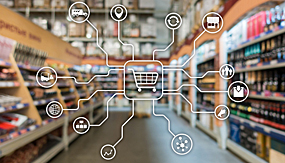
© AdobeStock
The “Yhteinen tietomalli” (shared data model) project will create a common digital language for the food sector that will enable information to flow seamlessly throughout the value chain, all the way to consumers. The Finnish Grocery Trade Association and the Finnish Food and Drink Industries’ Federation wish to create the most consumer-driven food value chain in the world with the project.
"The most important thing is to improve customer experience and cost-effectiveness simultaneously," says Jenni Särkkä of GS1 Finland, facilitator of the project. GS1 specialises in product data standardisation, as exemplified by the EAN bar code we all know. The “Yhteinen tietomalli” project also transfers information based on GS1 standards. “They function globally, so the solution we have developed will also help Finnish food operators to connect with international networks.”
Packaging labels to include information on product origin and sustainability
A roadmap for 2021–2025 was drawn up during the first phase of the project, which ended in the spring. The new form of communication will be introduced step by step. “The next goal for the subprojects is to improve digital interaction between producers and consumers,” says Särkkä. Labelling is a concrete development target.
The Identification Keys in accordance with the GS1 standard can be used to add a lot of information to the labelling that is valuable to food producers, suppliers, vendors and consumers. In particular, there is a desire to improve the flow of information online. “Online shopping has become an established way of buying goods for so many consumers that we need to come up with solutions that make it easy to compare products in the vast digital world.”
Digital labelling can provide consumers with information such as product sustainability, origin, carbon footprint and nutritional values. In addition, labelling can facilitate interaction between consumers and producers. “For example, the consumer can scan a product code with their phone in the store or with their own refrigerator and provide feedback directly to the food producer.”
Managing food waste with digital labels
There is also a desire to improve the flow of information throughout the value chain of food. Digitally readable labelling promotes stock management, thereby improving productivity and waste reduction. “After all, waste occurs when the right quantity of products is not obtained at the right time from production to suppliers, the market and consumers,” Särkkä says.
At the moment, attempts are being made to reduce waste in shops, for example by labelling products with red discount price tags. According to Särkkä, it would be more effective to respond to demand proactively. Then, everyone in the food value chain would be able to see in advance when there is demand for different products, when the next batch will be completed and when it will be sold out. “Efficient flow of information would make demand forecasts more accurate, enabling there to always be enough goods on the shelves while reducing waste.”
Developing the food sector together
The first phase of the “Yhteinen tietomalli” project coincided with the pandemic, which underlined the importance of a rapid response and cooperation within the food industry value chain. “It was great to see how the whole value chain came together to create the conditions for big changes. Everyone really does want to create our future together!”
In fact, improving consumer service and reducing food waste is only possible if the industry is capable to agree on a variety of issues. “Operators must define what information they want to convey to consumers in addition to the requirements of the law,” Särkkä says. “A common knowledge base creates a platform on which each actor can build its own competitive advantages in the future."
Learn more
Further information
- Jenni Särkkä, Chief Development Officer, GS1 Finland, jenni.sarkka@gs1.fi